TÌNH NGƯỜI TRONG CUỘC CHIẾN - CÂU CHUYỆN VỀ TRẠI CÙI BẾN SẮN.
bịnh cùi là một bịnh lây lan kinh niên, gây ra bởi vi trùng Mycobaterium leprae, một loại vi khuẩn hình que (rod). Bịnh phần lớn tác động vào da, các dây thần kinh ngoại vi, màn nhày của đường hô hấp trên và mắt, và một số cấu trúc khác của cơ thể. Bịnh cùi đã gây đau khổ cho (afflict) từ thời xa xưa. Nó từng ảnh hưởng mọi châu lục và đã để lại một hình ảnh gớm ghiết trong lịch sử và trí nhớ con người - với mất mát tay chân, sự hắt hủi (rejection) và xa lánh (exclusion) từ xã hội.
Bịnh cùi đã gieo rắc sợ hãi vào nhân loại từ hàng ngàn năm, và đã được ghi nhận đầy đủ trong những nên căn minh cổ xưa nhứt của TQ, Ai cập và Ấn độ. Có nhiều nước ở Á, Phi và châu Mỹ Latin với số lượng đáng kể người bị cùi. Người ta ước lượng có khoảng từ 1 đến 2 triệu người bị cùi, cần được chăm sóc.
Khi vi khuẩn Mycobacterium leprae được phát hiện bởi bác sĩ Hansen năm 1873, đây là vi khuẩn đầu tiên được nhận dạng gây bịnh ở người. Tuy nhiên việc trị bịnh chỉ xuất hiện vào cuối thập niên 1940 với sự ra đời của Dapsone, và các dẫn xuất từ thuốc này. Ngay cả bây giờ, nhiều người vẫn còn tin cùi là 1 bịnh khiến người mất ngón tay và ngón chân. Thực tế, bịnh chỉ gây tổn thương ở da, tấn công hệ thần kinh và khiến các ngón tay, ngón chân (extremities) mất cảm giác. Do đó, người cùi dễ tạo các tổn thương hay tự gây thương tích (ví dụ khi nhóm bếp), và những tổn thương này ko thể lành, cuối cùng khiến họ mất ngón tay ngón chân. Bây ko lây lan nhiều và có thể trị: nếu trị sớm sẽ có thể ko bị tàn phế.
Kể từ năm 1983, Việt Nam đã chứng kiến sự giảm đáng kể về tỷ lệ bệnh phong, nhờ vào việc áp dụng liệu pháp đa thuốc. Tỷ lệ bệnh đã giảm xuống dưới một ca trên 10.000 người từ năm 1995. Dân số hiện tại của Việt Nam là 101.438.184 người.
Vietnam has seen a significant decrease in the prevalence rate of leprosy since 1983, with the introduction of multidrug therapy. The prevalence of the disease has dropped to less than one case per 10,000 individuals from 1995. The current population of Vietnam is 101,438,184.
The Tan Uyen Leper Colony
Leprosy is a chronic infectious disease caused by Mycobacterium leprae, an acid-fast, rod-shaped bacillus or bacteria. The disease mainly affects the skin, the peripheral nerves, mucosa of the upper respiratory tract and also the eyes, apart from some other structures. Leprosy has afflicted humanity since time immemorial. It once affected every continent and it has left behind a terrifying image in history and human memory - of mutilation, rejection and exclusion from society.Leprosy has struck fear into human beings for thousands of years, and was well recognized in the oldest civilizations of China, Egypt and India. Since ancient times, leprosy has been regarded by the community as a contagious, mutilating and incurable disease. There are still many countries in Asia, Africa and Latin America with a significant number of leprosy cases. It is estimated that there are between one and two million people visibly and irreversibly disabled due to past and present leprosy who require to be cared for by the community in which they live.When M.leprae was discovered by G.A. Hansen in 1873, it was the first bacterium to be identified as causing disease in man. However, treatment for leprosy only appeared in the late 1940s with the introduction of Dapsone, and its derivatives. Even today, many believe leprosy is a disease that causes people's fingers and toes to fall off. Actually, the disease causes skin lesions, attacks the nervous system and numbs the extremities. As a result, lepers develop lesions or injure themselves (when lighting a fire, for example), and their injuries do not heal, ultimately causing them to lose the extremity. The disease is not very contagious and can be cured. Early treatment makes it possible to avoid disability.With a total population of 78.7 million, Vietnam currently has about 22,000 lepers, and the Government has made it a priority to eradicate this disease. Unfortunately, most lepers live in remote areas, and available resources are far from being enough to meet all of their needs.The 118th Thunderbirds participated in flying both US Army and US Air Force doctors from Bien Hoa to a leper colony only about 10-12 miles North of Bien Hoa just across the Song Dong Nai river. Flights usually took place on Saturday and Sunday with the doctors being dropped of to work for the day and returning to pick them up well before dark. Since leprosy was so rare to American doctors, many took advantage of the opportunity to see and treat the victims of the disease at the colony.Doctor Joseph Altomonte, MD, the 118th Thunderbird Flight Surgeon during 1965-66, made weekly visits to the Tan Uyen Leper Colony treating patients and local civilians. Likewise other Flight Surgeons, such as Dr. Marvin Marchman, MD, continued the weekly visits to the Colony. Everyone was always amazed at the fact that the Catholic run leper colony at Tan Uyen was most often avoided by the VC and no problems ever seemed to happen when US personnel went there. 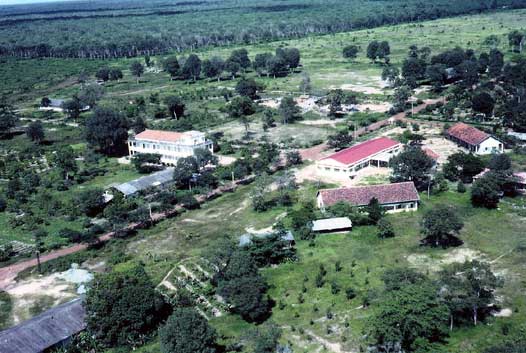
An aerial view of the Tan Uyen Leper Colony on bright sunshine day immediatelyN. across the Song Dong Nai river. (Oct 66)(Photo courtesy Tommy Thornton) 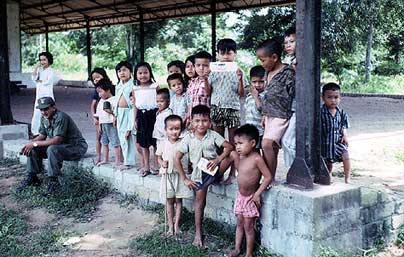 Dr. Joseph Altomonte, MD sitting with childrenat the Tan Uyen Leper Colony.(66)(Photo courtesy Tommy Thornton) Dr. Joseph Altomonte, MD sitting with childrenat the Tan Uyen Leper Colony.(66)(Photo courtesy Tommy Thornton) | 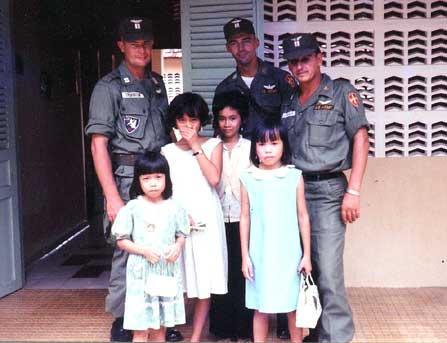 L to R: Tommy Thornton, Jack Waters and Dr. Joseph Altomonte with some of the girls at the colony. Note the bandage on the little girl at left and the one next to her covering her face.(8 May 66)(Photo courtesy Tommy Thornton) L to R: Tommy Thornton, Jack Waters and Dr. Joseph Altomonte with some of the girls at the colony. Note the bandage on the little girl at left and the one next to her covering her face.(8 May 66)(Photo courtesy Tommy Thornton) |
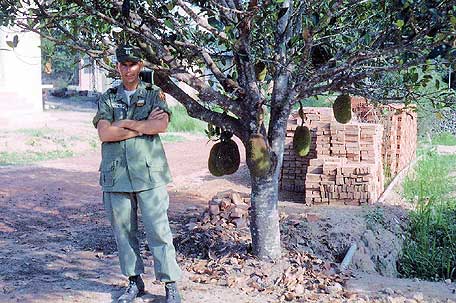 CPT Al Phillips standing under a Jack Fruittree growing on the grounds of theTan Uyen Leper Colony.(27 Apr 66)(Photo courtesy Tommy Thornton) CPT Al Phillips standing under a Jack Fruittree growing on the grounds of theTan Uyen Leper Colony.(27 Apr 66)(Photo courtesy Tommy Thornton) | 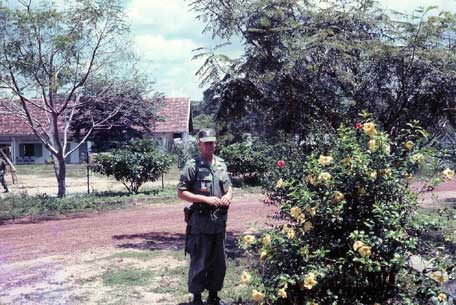 CPT Tommy Thornton standing next to flowersgrowing on the grounds of theTan Uyen Leper Colony.(Aug 66)(Photo courtesy Tommy Thornton) CPT Tommy Thornton standing next to flowersgrowing on the grounds of theTan Uyen Leper Colony.(Aug 66)(Photo courtesy Tommy Thornton) |
Return to Table of Contents









No comments:
Post a Comment